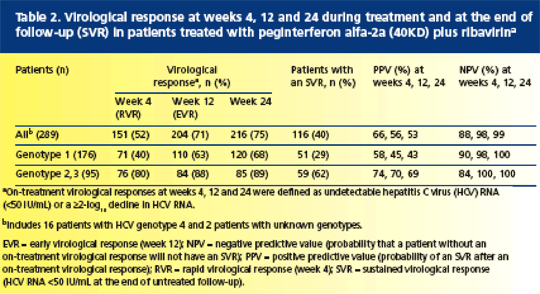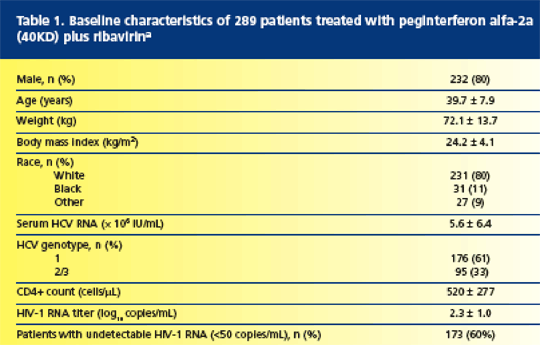 |
 |
 |
| |
Predictability of SVR at Week 4 in Coinfection in APRICOT Study
|
| |
| |
Reported by Jules Levin
"Predictability of sustained virological response (SVR) at week 4 in HIV-HCV co-infected patients treated with peginterferon alfa-2a (40KD) (PEGASYS}) + ribavirin (COPEGUS}) in the AIDS PEGASYS Ribavirin International Co-infection Trial (APRICOT)"
M. Rodriguez-Torres and colleagues reported at the 44th ICAAC (2004 October 30--November 2: Washington DC, USA) Study sponsored by Roche.
"....the optimal time to assess the NPV is week 12 rather than week 4..."
The aim of this study was to determine the predictive value of a rapid virological response at week 4 on the probability of achieving an SVR inHIV-HCV co-infected patients treated with peginterferon alfa-2a (40KD)(PEGASYS) plus ribavirin (COPEGUS) in APRICOT. The NPV and positive predictive value (PPV) of a rapid virological response at week 4 were then compared with the NPV and PPV of an early virological response at week 12.
The ability to identify patients who are most likely to achieve an SVR early during the course of treatment allows those individuals to be targeted for a complete course of therapy, thus, minimizing the overall costs of treatment and the likelihood of adverse events in those unlikely to achieve an SVR. In HCV mono-infected patients treated with peginterferon alfa-2a (40KD) plus ribavirin, the absence of an early virological response (defined as undetectable HCV RNA level or a minimum 2-log10 reduction in viral load by week 12 of therapy) has a high negative predictive value (NPV) regarding the likelihood of achieving an SVR. The results of APRICOT demonstrate that the 12-week predictability seen in mono-infected patients applies equally well in patients with HIV-HCV co-infection. In this analysis we examined the impact of a virological response at week 4 in predicting the outcome of treatment in patients enrolled in APRICOT.
Treatment for 48 weeks with the combination of peginterferon alfa-2a (40KD) (PEGASYS) plus ribavirin (COPEGUS) produced overall SVR rates up to 63% in HCV mono-infected patients with chronic hepatitis C, and pegylated interferon alfa plus ribavirin is recognized as the current treatment of choice. The results of APRICOT demonstrate that the benefits of peginterferon alfa-2a (40KD) plus ribavirin therapy extend to patients with HIV-HCV co-infection: In HIV-HCV co-infected patients, treatment for 48 weeks with the combination of peginterferon alfa-2a (40KD) (PEGASYS) 180 µg/week plus ribavirin (COPEGUS) 800 mg/day results in an overall SVR rate of 40%, and SVR rates of 29% and 62% in patients infected with HCV genotypes 1, and 2/3, respectively.
Overall, >50% of patients had a rapid virological response at week 4; however, the predictability value of such a test is not sufficient to recommend HCV RNA testing at week 4 of treatment as a management tool in patients with HIV-HCV co-infection.
In the absence of a rapid virological response (undetectable HCV RNA level or minimum 2-log10 decrease in HCV RNA) at week 4, the probability that a patient will not achieve an SVR at the end of follow-up (NPV: negative predictive value) is 88%. When the virological response is assessed at week 12, the NPV increases to 98% and is unchanged at week 24. Thus, the optimal time to assess the NPV is week 12 rather than week 4.
Patients with an early virological response (week 12) have a good chance of achieving an SVR, irrespective of HCV genotype. These results are consistent with those obtained in HCV mono-infected patients, and suggest that the 12-week predictability algorithm may be extended to patients with HIV-HCV co-infection.
TABLE 2
|
|
| |
| |
 |
|
| |
| |
The virological response rates at week 4, 12 and 24 and the associated PPV and NPV values are presented in Table 2.
Rapid virological response was defined as undetectable HCV RNA by qualitative PCR or a >=2-log10 decline in HCV RNA by quantitative PCR at week 4.
NPV was defined as the probability that a patient without an on-treatment virological response would not develop an SVR (ie no on-treatment virological response and no SVR).
PPV was defined as the probability that a patient with an on-treatment virological response would develop an SVR (ie both an on-treatment virological response and an SVR).
The rapid virological response rate at week 4 was 52% (151 of 289 patients. Seventeen of 138 patients (12%) who did not have a rapid virological response at week 4 developed an SVR by the end of follow-up. The PPV (positive predictive value) and NPV (negative predictive value) of a rapid virological response at week 4 were 66% and 88%, respectively.
When the rapid virological response data are grouped by HCV genotype, the trends were very similar to the week 4 predictability results for the overall population. The NPV was broadly similar.
The predictability value of an early virological response at week 12. The NPV improved from 88% at week 4 to 98% at week 12. Conversely the PPV decreased from 66% to 56% between week 4 and 12.
METHODS
Patients
Patients eligible for enrollment in APRICOT were HCV RNA and HCV antibody positive, had elevated serum alanine aminotransferase levels documented on two or more occasions within the previous 12 months, and had HIV-1 disease confirmed by detectable anti-HIV-1 antibodies or HIV-1 RNA in serum. Participants had compensated liver disease, a CD4+ cell count >=100 cells/µL and stable HIV disease. Patients were excluded if they had previously received interferon or ribavirin.
Study design
Patients were randomized to 48 weeks of treatment with one of three regimens:
• Peginterferon alfa-2a (40KD) 180 µg/week plus ribavirin 800 mg/day
• Peginterferon alfa-2a (40KD) 180 µg/week plus placebo
• Interferon alfa-2a 3 MIU three times per week plus ribavirin 800 mg/day.
The study design included a 24-week untreated follow-up phase, thus, all patients were to be followed for a total of 72 weeks.
SVR was defined as undetectable HCV RNA by qualitative polymerase chain reaction (PCR) assay (COBAS AMPLICOR® HCV Test v2.0, lower limit of detection 50 IU/mL) at the end of untreated follow-up (week 72).
Early virological response was defined as undetectable HCV RNA by qualitative PCR or a >=2-log10 decline in HCV RNA by quantitative PCR (COBAS AMPLICOR HCV MONITOR Test v2.0, limit of quantitation 600 IU/mL) at week 12.
This analysis is based on data from patients treated with peginterferon alfa-2a (40KD) plus ribavirin.
RESULTS
A total of 289 patients were treated with peginterferon alfa-2a (40KD) plus ribavirin. Baseline demographic and virological characteristics of these patients are shown in Table 1.
A total of 116 of 289 patients (40%) treated with peginterferon alfa-2a (40KD) plus ribavirin achieved an SVR. Among patients infected with HCV genotypes 1 or 2/3, the SVR rates were 29% (51/176) and 62% (59/95).
|
|
| |
| |
 |
|
| |
| |
|
| |
|
 |
 |
|
|